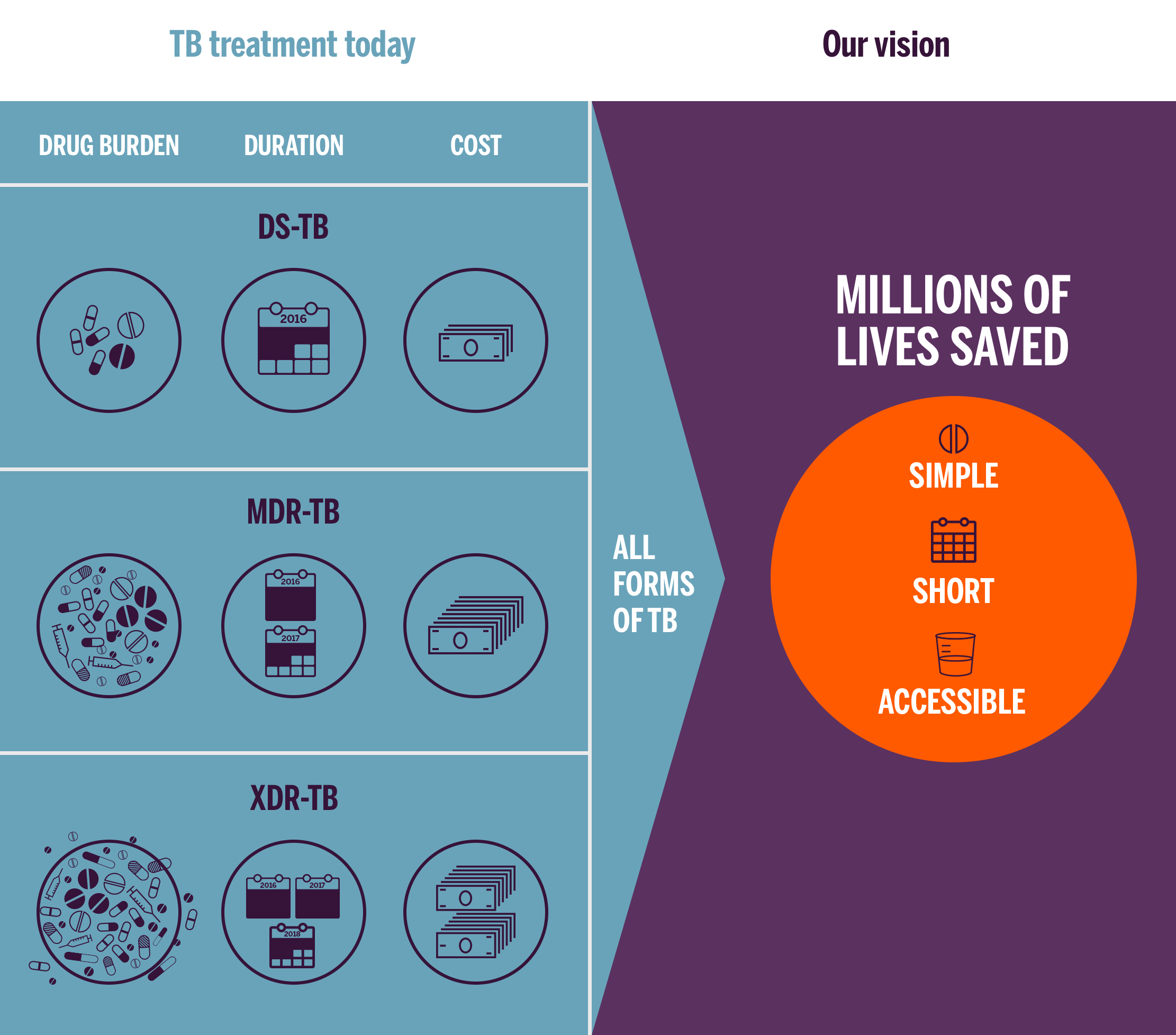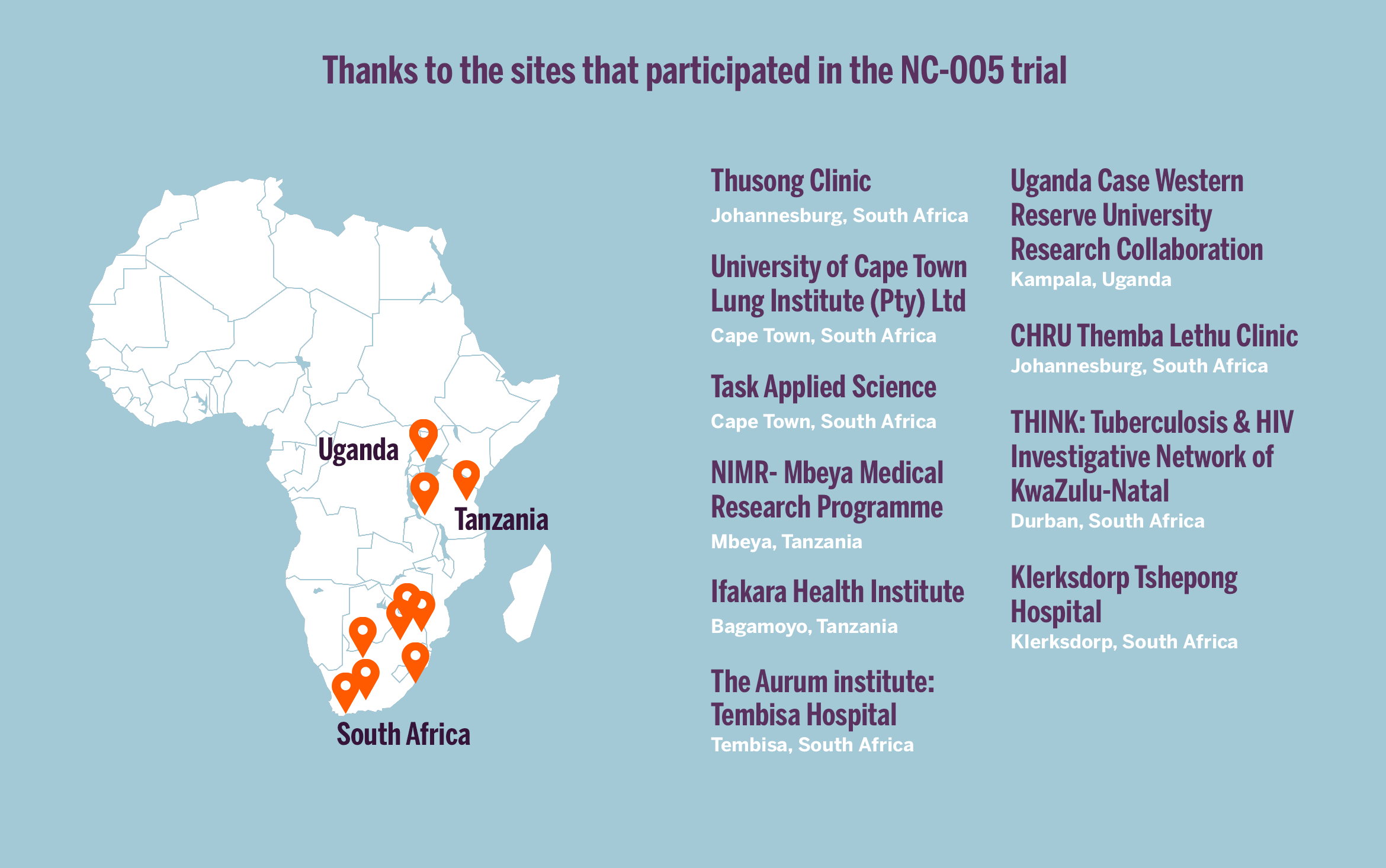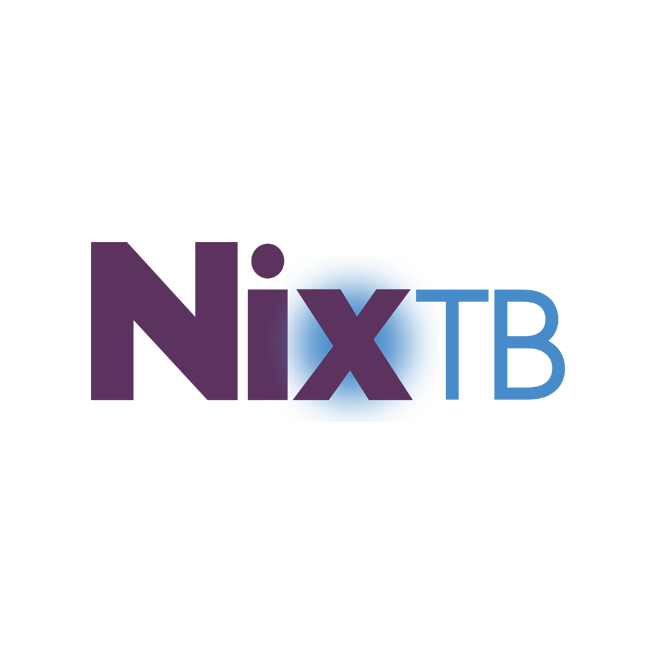



To end the global TB pandemic, we need improved treatments for all people with TB. Of tremendous excitement in 2015 was the progress TB Alliance and its partners made in our research and development pipeline. This includes research that hold the promise to shorten and improve the treatment of drug-sensitive and MDR-TB, and also a new trial testing a potential treatment for XDR-TB, giving those patients a markedly enhanced hope for cure.
These trials are part of our product development strategy and help advance our vision of a
universal regimen
— a single ultra-short, simple, and accessible TB treatment that works in virtually all people with tuberculosis. To do this,
we develop regimens that have reduced pill burden and duration of treatment, don't require injectable drugs, and will be accessible,
affordable and available to the patients who need them. Over the past year, TB Alliance made significant progress in the pursuit
of a universal regimen, as described through the milestones outlined below.
In 2015, TB Alliance completed enrollment of the NC-005 trial. This Phase 2b trial, conducted at 10 sites across Uganda, South Africa, and Tanzania, tested the efficacy and safety of BPaZ — bedaquiline (B), pretomanid (Pa), and pyrazinamide (Z) — over the course of two months of treatment. The trial also investigated a simpler dosing scheme for bedaquiline that could lead to fewer pills and an overall less complicated treatment for patients. Approximately 240 patients participated in the trial.
BPaZ is projected to be the shortest regimen of those currently in clinical development.
Earlier studies and pre-clinical research shows that it has promise to reduce TB treatment to as little as three months — cutting treatment time by half for people with drug-sensitive TB, and to just an eighth of the current two-year treatment time for people with MDR-TB.
As bedaquiline and pretomanid are two novel agents, BPaZ has the potential to be useful in virtually all drug-sensitive TB patients, as well as approximately half of MDR-TB patients. If successful, the results of NC-005 could give way to a global Phase 3 trial that could lead to the worldwide registration of the BPaZ treatment. Results will be available in 2016.


Nix-TB is a critical step in the development of a universal treatment for all types of TB, as it is the first study to test a treatment comprised of all drugs with minimal or no pre-existing resistance. As such, if found to be safe and effective, the treatment could potentially be expanded for use in other types of patient populations. To read more about progress in the trial and its significance on the pathway toward a universal regimen, click here.
TB Alliance and partners are advancing the largest portfolio of TB treatments in history.
In the area of early research and discovery, 2015 was an exciting year as TB Alliance progressed more compounds than ever before in our history.
We formally joined the Bill and Melinda Gates Foundation TB Drug Accelerator (TBDA) as a full partner. This allows us to markedly expand our collaborations with public and private partners working in the area of TB drug discovery and pre-clinical development. Through the TBDA, we can meaningfully contribute, adding knowledge and experience, and advance what we hope will be an expanded number of drug discovery portfolio candidates in the coming years.
In terms of projects, of particular importance was the advancement into preclinical development of a program which focuses on the enzyme DprE1, which is involved in cell wall biosynthesis.
The treatment represents a new class of drugs and has a novel mechanism of action. This is important in fighting both drug-sensitive and drug-resistant strains of the disease.
Other progress was seen in our portfolio of work with Japanese companies, funded through Global Health Innovative Technology Fund (GHIT). The partnerships with Daiichi Sankyo and Shionogi resulted in the advancement of compounds from screening programs to the hit-to-lead stage. The number of programs also expanded, with new partnerships formed with Chugai, Daiichi Sankyo Novare, HyphaGenesis, Mitsubishi-Tanabe, OP-Bio, and Sumitomo-Dainippon.
Over the course of the last year, TB Alliance expanded its focus on natural products — that is, compounds that are found from microorganisms and plants. Many of our partnerships with GHIT, as well a new partnership with Universitas Gadjah Mada in Indonesia, funded by the Indonesia Health Fund, are focused on this area. Because of the evolutionary process over millennia, many natural products are thought to have antibacterial activity and indeed, many of the current antibacterials today such as rifampicin have their roots in natural products. Conducting this type of antibiotic discovery using modern-day technology holds promise for uncovering novel TB drugs.
Other partners gained during 2015 include Roche, which is now collaborating with TB Alliance to test their PEPCK program compounds for anti-TB activities, and Schrödinger, which is enhancing our discovery capabilities by introducing cutting-edge computational chemistry and structure-guided drug design to several programs.
Meanwhile, our current partners, including GlaxoSmithKline and Sanofi, are advancing several programs toward candidate nomination.
This year, we have also seen the advancement of many of our discovery programs from early to advanced status within the lead identification and lead optimization phases of development. For example, seven programs in the lead optimization phase are in an advanced stage of this process, with potential to enter preclinical development in the next two years pending successful outcomes of current studies. All of these programs focus on compounds that work against drug-sensitive and drug resistant strains, and therefore could help advance progress toward our vision of a universal regimen. This work lays the groundwork for what should be a tremendously successful 2016 and delivery of novel clinical compounds at a sustainable rate, in 2017 and beyond.
The research and development of new TB treatments is not without risk; setbacks and attrition are to be expected.
Currently, the Phase 3 STAND trial, testing the PaMZ regimen, is on partial clinical hold. While participants in the study are continuing in the trial, new enrollment has been paused. This pause was recommended in 2015 by the trial's Data Safety Monitoring Committee (DSMC), so they could further analyze data related to potential toxicity and for TB Alliance to institute other changes in the trial to enhance patient safety. Since then, the DSMC has reviewed additional unblinded data and recommended that the trial resume enrollment.
TB Alliance is now reaching out to multiple constituencies, such as the relevant regulatory agencies, before making a definitive decision on how to re-start the trial. Updates on the trial's status can be found here.
In January 2016, TB Alliance announced that it voluntarily halted further dosing of its Phase 1 compound, TBA-354, due to unexpected signs detected in clinical trial participants who were administered the compound. The organization has now made a decision to end this clinical trial program.
